Military order (monastic society)
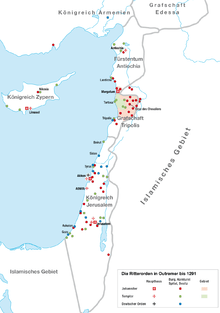
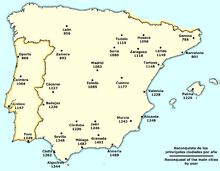
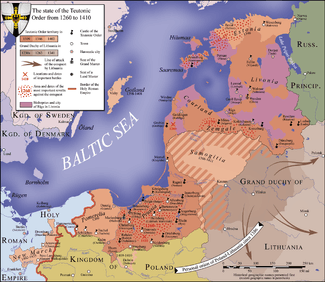
A military order (Latin: Militaris ordinis) is a chivalric order with military purpose originally established as Catholic religious societies during the medieval Crusades for protection of Christians against violent persecution of the Islamic conquests (623–) in the Holy Land and the Iberian Peninsula, as well as by Baltic paganism in Eastern Europe.
Most members, often titled Knights, were and still are laymen, and not prelates, yet cooperating with the clergy, sometimes even taking religious vows such as poverty, chastity, and obedience, according to monastic ideals. As such, it was in the military orders that the Medieval concept of chivalry reached its apogee in an exceptionate fusion under exceptionate circumstances of military discipline and Christian virtues.
Prominent examples include the Knights Hospitaller, and the Knights Templar in Outremer, as well as the Teutonic Knights in the Baltics.[1]
Many military orders were suppressed by the Holy See in Rome around the end of the Middle Ages, with few new recognised establishments afterwards. However, some persisted longer in its original functions, only later evolving into purely honorific and/or ceremonial chivalric orders with charitable aims in modern times, such as the Sovereign Military Order of Malta and the Order of the Holy Sepulchre, both Papal orders of knighthood conferred still today. Notably, the Teutonic Order became exclusively monastic except a limited associated confraternity of honorary Knights.
Today a Western cultural heritage and legacy, besides those officially recognised by the Holy See, parallel honorific institutions of unilateral Catholic adherence exist in continuous or revived forms among a few current and former European royal houses.
These traditions in turn eventually influenced honorific orders of modern states today, including that of secular republics, such as orders of merit, and other parts of honour systems and phaleristics.
Moreover, it inspired many subsequent modern era secular Western cultural phenonomens, such as fraternities, or brotherhoods, such as the Freemasonry.
History
Already in 1053, for the Battle of Civitate the Knights of Saint Peter (Milites Sancti Petri) was founded as a militia by Pope Leo IX to counter the Normans.[2]
The larger threat that would definitively establish the tradition, however, came from the east. In response to the Islamic conquests of the former Byzantine Empire and Christianity in the Holy Land, numerous Catholic military orders were set up following the First Crusade. The founding of such orders suited the Catholic church's plan of channelising the devotion of the European nobility, and also complemented the Peace and Truce of God.[1] The foundation of the Knights Templar in 1118 provided the first in a series of tightly organised military forces for the purpose of fighting invading Islamic conquests in the Holy Land and in the Iberian Peninsula — see the Reconquista — as well as Islamic invaders and pagan tribes in Eastern Europe.
The first secularised military order was the Order of Saint George, founded in 1326 by the King Charles I of Hungary, on which he made all the Hungarian nobility swear loyalty to him. The next secular order which is known to appear was the Order of the "Knights of the Band", founded in 1332 by the King Alfonso XI of Castile. Both orders existed only for about a century.[3]
Purpose
The original features of the military orders were the combination of religious and military ways of life. Some of them, like the Knights Hospitaller and the Knights of Saint Thomas, also had charitable purposes and cared for the sick and poor. However, they were not purely male institutions, as nuns could attach themselves as convents of the orders. One significant feature of the military orders is that clerical brothers could be, and indeed often were, subordinate to non-ordained brethren.
In 1818, the orientalist Joseph von Hammer compared the Catholic military orders, in particular the Knights Templar, with certain Islamic models such as the Shia Islamic sect of Assassins. In 1820, José Antonio Conde suggested they were modeled on the ribat, a fortified religious institution which brought together a religious or hospital way of life with fighting the enemies of Islam. However popular such views may have become, others have criticised this view, suggesting there were no such ribats around the Outremer until after the military orders had been founded.
Yet, the innovation of the role and function of the military orders has sometimes been obscured by the concentration on their military exploits in the Holy Land, Prussia, and the Baltics. In fact, they had extensive holdings and staff throughout Western Europe. The majority were laymen. They provided a conduit for cultural and technical innovation, for example the introduction of fulling into England by the Knights Hospitaller, or the banking facilities of the Knights Templars.
Because of the necessity to have a standing army, the military orders were founded, being adopted as the fourth monastic religious vows.
List of military orders
These are military orders listed chronologically according to their dates of foundation and extinction, sometimes approximate due to scarce sources, and/or repeated suppressions by Papal or royal authourities. Their militarisation may vary from case to case, the foundation of an order, its ecclesiastical approval, and occurring on different times and for different purposes. Presently active institutions are listed in consideration with their legitimacy according to the International Commission on Orders of Chivalry.
They are divided into international and national according to their adherence, mission, and enrolment, disregarding the extent of eventual gradual geographical distribution outside of their region of concern.
International
| Symbol | Name | Founded | Founder | Origin | Recognition | Protection | Extinction | Notes |
|---|---|---|---|---|---|---|---|---|
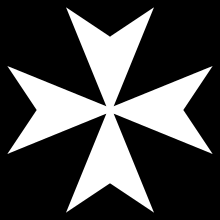 |
Knights Hospitaller (Sovereign Military Order of Malta) |
c.1099 1113 |
Gerard Thom | Jerusalem, Latin Kingdom of Jerusalem | 1113 by Pope Paschal II | Grand Master (1113-), Prince (1607-), Cardinal (1630-) |
Today the Catholic Order is known as the Sovereign Military Order of Malta. Officially it still remains a Catholic order, however continuous Regional connections are claimed by Freemason bodies and the Protestant chivalric orders of the Alliance of the Orders of Saint John of Jerusalem.[4][5] | |
 |
Order of the Holy Sepulchre | c.1099 1113 1122 |
Godfrey of Bouillon | Jerusalem, Latin Kingdom of Jerusalem | 1113 by Pope Paschal II 1122 by Pope Calistus II |
Kingdom of Jerusalem to 1291, Custos of the Holy Land: 1230-1489, Pope: 1489- |
Awarded to prominent pilgrims. Reorganised as Sacred and Military Order of the Holy Sepulchre in 1496 by Pope Alexander VI. Reorganised by Pope Pius IX with the residential restoration of the Latin Patriarchate of Jerusalem in 1847.[6] Known as the Equestrian Order of the Holy Sepulchre of Jerusalem since 1931. | |
 |
Knights Templar (Order Of Christ) |
c.1118 | Bernard of Clairvaux, Hugues de Payens |
Jerusalem, Latin Kingdom of Jerusalem | 1129 by Pope Honorius II until 1312 by Pope Clement V |
Pope: 1129-1312 | 1312 | The Knights Templar order was reconstituted in Portugal after the Templars were abolished on 22 March 1312 by the papal bull,Vox in excelso, issued by Pope Clement V.[7][8] King Dinis I of Portugal created the Order of Christ (Portugal) in 1317 for those knights who survived their mass slaughter throughout Europe and was officially founded in 1319,[9][10][11] The property of the Templars was transferred to the Knights Hospitaller except in the Kingdoms of Castile, Aragon, and Portugal.In effect, causing the dissolution of the Templars by the rival order.[12][13]
Thus when being recognized, the Pope allowing only the “Order Of Christ” a Portuguese order and it's Papal branch can claim to have any descent from the Templars, which is now used for Honorary State merits in Portugal and preserved as such.[12][14][15] |
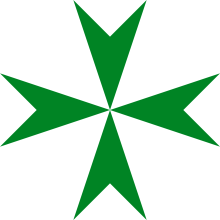 |
Order of Saint Lazarus (Order of Saints Maurice and Lazarus) |
c.1118 | Jerusalem, Latin Kingdom of Jerusalem | 1255 by Pope Alexander IV until 1489 by Pope Innocent VIII |
King Fulk of Jerusalem: 1142 Pope: circa 1255-1572 House of Savoy: 1572- House of France: 1609-1830, 2004- |
1489, 1572, 1609, 1830 (1856) |
Italian branch merged 1572 with the Order of Saint Maurice to form the Order of Saints Maurice and Lazarus under the Royal House of Savoy, still extant.
In 1609, King Henry IV of France linked it in France administratively to the Order of Our Lady of Mount Carmel to form the Royal Military and Hospitaller Order of Our Lady of Mount Carmel and Saint Lazarus of Jerusalem united, which remained listed as of royal protection in the French Royal Almanac until 1830.[16] Royal protection of the Royal house of France renewed 2004. |
National
| Symbol | Name | Founded | Founder | Origin | Recognition | Protection | Extinction | Notes |
|---|---|---|---|---|---|---|---|---|
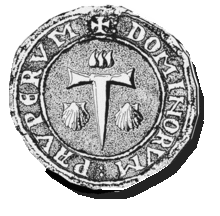 |
Order of Saint James of Altopascio | 1075 (1084) |
Matilda of Tuscany | Altopascio, Tuscany, Holy Roman Empire | 1239-1459, but mentioned in a Papal bull 1198 of Pope Innocent III |
Properties of the hospice of "Altopassus" in Italy confirmed in 1244 by Emperor Frederick II | 1459, 1587, 1672 |
Primarily provided safety and protection to Italian pilgrims to the Holy Land and Camino de Santiago. Merged with the Order of Saint Stephen in 1587 by Pope Sixtus V at request of Grand Duke of Tuscany. In France absorbed into the Order of Saint Lazarus in 1672. |
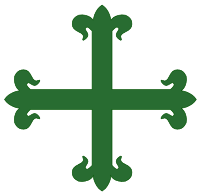 |
Order of Aviz | 1146 (1128) |
Avis, Portugal | Received a grant in 1129 by Theresa, Countess of Portugal House of Aviz: 1385-1580 |
1789 | Secularised 1789. Statutes revised repeatedly together with the other Portuguese orders of merit, during the First Republic (1910–1926), then in 1962, and again in 1986. | ||
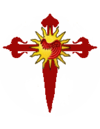 |
Order of Saint Michael of the Wing | 1147 (1171) (1828/ 1848/ 1986) |
King Afonso I of Portugal | Santarém, Portugal | First statutes approved in 1171 by Pope Alexander III | House of Braganza: 2001- | 1732 | Abandoned by 1732,[17] restored[18] by King Miguel I in 1828[19] during his brief rule before losing the Liberal Wars to his brother King Pedro IV,[20] revived 1848[18]/1986 [21] |
 |
Order of Calatrava | 1158 | Raymond of Fitero | Calatrava la Vieja, Kingdom of Castile, Spain | 1164 by Pope Alexander III | House of Bourbon | 1838 by secularisation | King Charles III of Spain requested old orders to contribute to his new order in his name (1775), which led to dissolution. Confiscated by King Joseph (1808), re-established by Ferdinand VII at the Restoration (1814). Secularised in 1838. |
 |
Order of the Holy Ghost | 1161 | Guy de Montpellier | Provence, France | ca. 1161–June 16, 1216 by Pope Innocent III in Santo Spirito in Sassia, Rome | 1692/ 1700/ 20th century |
Historically both religious and chivalric. In 1692 in France, King Louis XIV merged it with his own Order of Our Lady of Mount Carmel. The remaining organisation was edicted in 1700 as purely religious order.[22] Offshoots of the order in France survived into the 20th century. | |
 |
Order of Aubrac | 1162 | Aubrac, France | 18th century | Disappeared during the French Revolution in late in the 18th century. | |||
 |
Order of Santiago | 1170 | León or Uclés in Castile, Spain | By Papal bull 5 July 1175 by Pope Alexander III | House of Bourbon | |||
 |
Order of Alcántara | 1177 | Alcántara, Extremadura, Spain | |||||
 |
Order of Mountjoy | 1180 | Holy Land | 1221 | Merged into the Order of Calatrava. | |||
 |
Teutonic Knights | 1190 | Acre, Israel | Converted into a purely Catholic religious order since 1929. | ||||
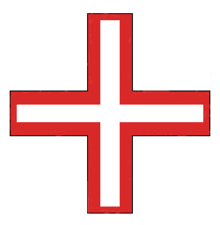 |
Hospitallers of Saint Thomas of Canterbury at Acre | 1191 | 1538 | |||||
 |
Order of Monfragüe | 1196 | 1221 | Merged into the Order of Calatrava. | ||||
 |
Order of Sant Jordi d'Alfama | 1201 | 15th century | Early 15th century, merged into the Order of Montesa. | ||||
 |
Livonian Brothers of the Sword | 1202 | 1236 | Merged into the Teutonic Order as the Order of Livonia, disbanded 1561. | ||||
 |
Order of Dobrzyń | 1216 | Dobrzyń Land, Poland | 1240 | Small number, maximum 35 knights. Battled by the Prussians, around 1235 most knights joined the Teutonic Order. In 1237 the rest of the brothers reinforced Drohiczyn by order of Konrad. Last mentioned when Drohiczyn was captured by Prince Daniel of Kiev in 1240. | |||
 |
Militia of the Faith of Jesus Christ | 1221 | 1285 | Note: Symbol that of the Dominican Order. Merged into the Third Order of Saint Dominic. | ||||
 |
Military Order of Monreal | 1231 | King Alfonso the Battler | Monreal del Campo, Aragon | 1143 1150 |
|||
 |
Order of the Faith and Peace | 1231 | 1273 | |||||
 |
Knights of the Cross with the Red Star | 1233 | Agnes of Bohemia | Bohemia | 1237 by Pope Gregory IX Confirmed 1292 by ambassador of Pope Nicholas IV |
Mainly hospitals, in Bohemia still existing. | ||
 |
Militia of Jesus Christ | 1233 | Bartolomeo da Vicenza | Parma | 22 December 1234 by Pope Gregory IX. | 1250s | Disappeared mid-13th century. | |
 |
Order of the Blessed Virgin Mary | 1261 | Loderingo degli Andalò, Catalano dei Malavolti, Ugolino Lambertini | Bologna | 23 December 1261 by Pope Urban IV | 1556 | ||
 |
Order of Saint Mary of Spain | 1270 | 1280 | Merged into the Order of Santiago. | ||||
 |
Order of Montesa | 1317 | ||||||
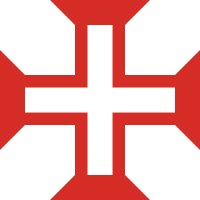 |
Order of the Knights of Our Lord Jesus Christ (Knights Templar) |
1317 1917 |
Portugal | 1789 1910 |
Secularized 1789. | |||
 |
Order of the Dragon | 1408 | 1475s | Disappeared late 15th century. | ||||
 |
Order of Saint Maurice | 1434 | Amedeo VIII of Savoy | Château de Ripaille, Thonon-les-Bains, Savoy | 1572 | Merged with the Order of Saint Lazarus in Italy in 1572 by Pope Gregory XIII into Order of Saints Maurice and Lazarus, considered the legitimate successor of both by the ICOC. | ||
 |
Order of the Tower and Sword | 1459 | King Afonso V of Portugal | Portugal | Revived 1808 by Prince Regent John, later John VI of Portugal. Since the end of the monarchy in 1910, all military orders abolished except the Order of the Tower and Sword, with President of Portugal ex officio its Grand Master. | |||
 |
Order of Our Lady of Bethlehem | 1459 | Pope Pius II | Lemnos, Byzantine Empire | 18 January 1459 by Pope Pius II | 1460 | Founded in 1453 by Pope Pius II after the Fall of Constantinople to the Ottoman Empire, to defend the island of Lemnos, soon recaptured by the Turks, thus rendered useless and suppressed almost as soon as founded.[23][24] | |
 |
Order of Saint George of Carinthia | 1469 | Emperor Frederick III, Holy Roman Emperor | In 1469 by Pope Paul II | Abolished 26 July 1598 (1732?) |
|||
 |
Sacred Military Constantinian Order of Saint George | 1522-1545 (1520?)(1550?) |
Angeli Comneni family | Addressed in 1550 by Pope Julius III Cardinal protector in 1910 by Pope Pius X |
Decrees by King Philip III of Spain, Ferdinand II, Holy Roman Emperor on 7 November 1630 | Appears to have been established between 1520 and 1545, with certain statutes dated 1522 by the Angeli Comneni family. Its Grand Master Andrea Angelo Flavio Comneno was addressed first in 1550 by Papal bull Quod Aliasla by Pope Julius III. | ||
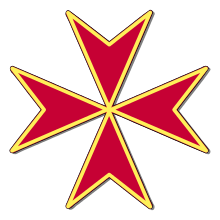 |
Order of Saint Stephen Pope and Martyr | 15 March 1561 | Cosimo I de' Medici, Grand Duke of Tuscany | Tuscany | 1 October 1561 by Pope Pius IV | Founded as Benedictine order by Cosimo I de' Medici,.[25][26] dedicated to the martyred Pope Stephen I and the victories at the Battle of Montemurlo in 1537 and the Battle of Marciano (Scannagallo) in 1554. Fought the Ottoman Turks and pirates in the Mediterranean Sea. Abolished in 1859 by the annexation of Tuscany to the Kingdom of Sardinia.[27] Present, Catholic continuation claimed by Archduke Sigismund, Grand Duke of Tuscany.[28][29] |
Other
Chivalric and/or military orders that could qualify depending on definition.
- Confraternity of Belchite, "experimental" confraternity of knights founded in 1122 by King Alfonso the Battler of Aragon
- Order of Saint Blaise, founded in the 12th century in Armenia to defend the country against the attacks of the Muslims
- Order of Saint George (Kingdom of Hungary), world's first secular chivalric order founded in 1326 by King Charles I of Hungary
- Knights of the Band, early honorific military order founded c. 1330 by King Alfonso XI of Castile
- Order of the Most Holy Annunciation, military order founded in 1350 by Duke Amadeus VI, Count of Savoy, the first called the Order of the True Lover's Knots in memory of a bracelet of hair presented to the founder by a lady, but upon the election of Amadeus VIII to the pontificate in 1439, it changed its name for that of the Annunciation of angel Gabriel
- Order of the Dove, short-lived (one year) and controversial order founded in 1379 by King Juan I of Castile
- Order of Saint Anthony (Bavaria), Bavarian military order founded in 1382 by Duke Albert I, Duke of Bavaria
- Military Order of Cross-bearers with the Red Star on a Blue Field, hospitaller and/military order active from the 12th century until suppressed in 1656 by Pope Alexander VII.
- Order of Saint Hubert, early honorific military order founded in 1444 or 1445 by Gerhard VII, Duke of Jülich-Berg
- Blood of Jesus Christ (military order), founded in Mantua, Italy, by Vincenzo I Gonzaga, Duke of Mantua, approved on 25 May 1608 by Pope Paul V
- Order of the Knights of Concórdia, founded in 1246 by King Ferdinand III of Castile
Modern development
A few of the institutions survived into honorific and/or charitable organisations, including the papal orders of knighthood.
While other contemporary Catholic societies may share some military organisational features and ideology, such as the Society of Jesus (1540),[30] they differ from the medieval military orders in absence of military purposes or potential.
As for several national, state and even dynastic military orders of merit, such as the Dutch Military Order of William and the Austrian Military Order of Maria Theresa, they are not military orders other than nominally.
Echoing the medieval institutions, however, it is possible for modern orders to be founded explicitly as a military order, for instance the Military Order of Loyalty (Spanish: Orden Militar de la Constancia), founded in 1946 by the Spanish protectorate in Morocco. Awarded to both Spanish and Moroccan military officers and soldiers, the single-class order was abolished in 1956.
In contrast, inspired by the legacy of the original military orders, besides legitimate chivalric orders, in addition, vast modern imitations flourish, referred to as "self-styled orders".
See also
References
- 1 2 Crawford, Paul (1996). "The Military Orders: Introduction". The ORB: On-line Reference Book for Medieval Studies. Archived from the original on 6 October 2014.
- ↑ Template:Ref-Demurger-Templiers
- ↑ Michael Jones ed., The New Cambridge Medieval History, vol. 6: c. 1300 - c. 1415, (Cambridge, 1998), p. 209.
- ↑ Beyond the Craft by Keith B Jackson, published 1980 by Lewis Masonic (Terminal House, Shepperton, Middlesex, TW17 8AS, England), and subsequent later revised editions. Current (5th) edition (2005) is ISBN 0-85318-248-5.
- ↑ The Orders of Saint John Joint Declaration dated 14 October 1987.
- ↑ "Equestrian Order of the Holy Sepulchre of Jerusalem". Retrieved 24 January 2015.
- ↑ Robert Ferguson (26 August 2011). The Knights Templar and Scotland. History Press Limited. p. 39. ISBN 978-0-7524-6977-5.
- ↑ Jochen Burgtorf; Paul F. Crawford; Helen J. Nicholson (28 June 2013). The Debate on the Trial of the Templars (1307–1314). Ashgate Publishing, Ltd. p. 298. ISBN 978-1-4094-8102-7.
- ↑
 Herbermann, Charles, ed. (1913). "Order of the Knights of Christ". Catholic Encyclopedia. New York: Robert Appleton Company.
Herbermann, Charles, ed. (1913). "Order of the Knights of Christ". Catholic Encyclopedia. New York: Robert Appleton Company. - ↑ Matthew Anthony Fitzsimons; Jean Bécarud (1969). The Catholic Church today: Western Europe. University of Notre Dame Press. p. 159.
- ↑ Helen J. Nicholson (1 January 2004). The Crusades. Greenwood Publishing Group. p. 98. ISBN 978-0-313-32685-1.
- 1 2 José Vicente de Bragança, The Military Order of Christ and the Papal Croce di Cristo
- ↑ Martin, pp. 140–142.
- ↑ "Note of Clarification from the Secretariat of State". news.va. Pontifical Council for Social Communication. 16 October 2012. Retrieved 27 November 2012.
Vatican City,(VIS)-
- ↑ Noonan, Jr., James-Charles (1996). The Church Visible: The Ceremonial Life and Protocol of the Roman Catholic Church. Viking. p. 196. ISBN 0-670-86745-4.
- ↑ Moeller, Charles. "The Military Orders." The Catholic Encyclopedia Vol. 10. New York: Robert Appleton Company, 1911. 22 Jun. 2015
- ↑ Anderson, James (1732). Royal genealogies: or, The genealogical tables of emperors, kings and princes, from Adam to these times; in two parts. London: James Bettenham. pp. ix. Retrieved 9 December 2011.
St Michael's Wing in Portugal founded by the said King Alphonse 1165 or 1171 after his obtaining a notable Victory over Moors and Alberto King of Seville in which Battle MICHAEL the Arch Angel is said to appear on the right Side of Alphonse and fight against them. This Order is now out of use. (1732)
- 1 2 Almeida, Gomes Abrunhosa Marques de and Manuel Ângelo (2007). Precedentes histórico-teóricos dos regionalismos dos Açores e da Galiza. Santiago de Compostela: Univ Santiago de Compostela. p. 187.
- ↑ Cheke, Marcus (1969). Carlota Joaquina, queen of Portugal. (Reprinted. ed.). Freeport, N.Y.: Books for Libraries Press. p. 195. ISBN 978-0-8369-5040-3.
- ↑ Jenks, George C (1911). Monarchs in Exile, The Bookman vol. 32. New York: Dodd, Mead and Co. p. 273.
- ↑ Sainty, Guy Stair (2006-11-22). "Royal Order of Saint Michael of the Wing". rec.heraldry. Retrieved 2011-01-21.
While the Duke of Braganza is the unquestioned heir and successor of Dom Miguel, the institution of the Royal Brotherhood of St Michael of the Wing is better seen as a modern memorial revival of the original institution than any kind of continuation of the Miguelist award.
- ↑ Orders of the Holy Ghost - Catholic Encyclopedia article
- ↑ Besse, Jean. "Bethlehemites." The Catholic Encyclopedia Vol. 2. New York: Robert Appleton Company, 1907. 23 Jun. 2015
- ↑ Trollope, Thomas Anthony. An encyclopædia ecclesiastica, 1834
- ↑ Pasquale Villari, '"The Medici" (1911). Hugh Chisolm, ed. The Encyclopaedia Britannica: a dictionary of arts, sciences, literature and general information, Volume 18 (11 ed.). New York: Encyclopaedia Britannica. p. 36.
- ↑ Woodhouse, Frederick Charles (1879). The military religious orders of the Middle Ages: the Hospitallers, the Templars, the Teutonic knights, and others. With an appendix of other orders of knighthood: legendary, honorary, and modern. New York: Society for Promoting Christian Knowledge. p. 338.
The members followed the rule of St Benedict and the Popes granted them the same privileges as those enjoyed by the Knights Hospitallers
- ↑ Carmichael, Montgomery (1901). In Tuscany: Tuscan Towns, Tuscan Types and the Tuscan Tongue. New York: E P Dutton. p. 173.
The Order was swept away by the French Revolution but was revived again in a modified form in 1817. The Italian Revolution once more swept it away beyond hope of revival on 16 November 1859 and its Church and property became the property of the State. Alas that modern Italy should not be a little more tender of the memories of her past glories.
- ↑ Bernardini, Rodolfo (1990). Il Sacro Militare Ordine di Santo Stefano Papa e Martire (in Italian). Pisa: Familiare della Casa Asburgo Lorena.
- ↑ Cardinale, Hyginus Eugene (1983). Orders of knighthood awards and the Holy See. Gerrards Cross: Van Duren. p. 157. ISBN 978-0-905715-13-1.
- ↑ Harro Höpfl (2004), Jesuit Political Thought: The Society of Jesus and the State, c. 1540–1630, Cambridge; p. 25
Further reading
- "Military Orders" in Catholic Encyclopedia (1911)
- Nicholson, Helen J. The Knights Hospitaller (2001).
- Riley-Smith, Jonathan. Hospitallers: The History of the Order of St John (1999).
- Morten, Nicholas Edward. The Teutonic Knights in the Holy Land 1190-1291 (Woodbridge: Boydell Press, 2009)
- Burman, Edward (1988). The Templars: Knights of God. Inner Traditions/Bear.
- Forey, Alan John. The Military Orders: From the Twelfth to the Early Fourteenth Centuries. *(Basingstoke: Macmillan Education, 1992)

